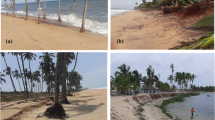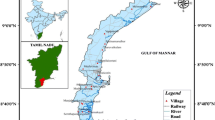Abstract
Coastal pollution and encroachment in India are ever-growing issues, for which the Indian government drafted coastal regulation notifications for better management. However, many violations have occurred but not documented due to paucity in data. In recent decades, remote sensing tools are widely used to estimate encroachment and violations, where such official data are not available. This study uses satellite imagery to estimate violations that have occurred in the years 2002, 2008, 2014 and 2019, along the coastal regions of Maharashtra, India. Spatiotemporal variations in violations were assessed and classified into four violation classes: < 25%, 25–50%, 50–75% and > 75%. Over the study period, violations in the class > 75% increased by 110% while violations in the < 25% class decreased by 10%, indicating not a reduction in low violations, but a significant conversion of low to maximum violation scenarios. Particularly, metropolitan areas like Mumbai had higher violations when compared to other areas. Reasons for these violations include increased urbanization and regional occupations like fishing. This study has provided information on hotspots of violation areas that could help reformulate, execute and inspect the coastal regulations.








Similar content being viewed by others
References
Agoramoorthy, G., Chaudhary, S., Chinnasamy, P., & Hsu, M. J. (2016). Harvesting river water through small dams promote positive environmental impact. Environmental Monitoring and Assessment, 188(11), 645.
Alizadeh, M. J., Kavianpour, M. R., Danesh, M., Adolf, J., Shamshirband, S., & Chau, K. W. (2018). Effect of river flow on the quality of estuarine and coastal waters using machine learning models. Engineering Applications of Computational Fluid Mechanics, 12(1), 810–823.
Allam, Z., & Jones, D. (2019). Climate change and economic resilience through urban and cultural heritage: The case of emerging small island develo** states economies. Economies, 7, 62.
Castilla, G., Hay, G. G., & Ruiz-Gallardo, J. R. (2008). Size-constrained region merging (SCRM). Photogrammetric Engineering & Remote Sensing, 74(4), 409–419.
Chinnasamy, P., & Agoramoorthy, G. (2016). India's groundwater storage trends influenced by tube well intensification. Groundwater, 54(5), 727–732.
Chinnasamy, P., & Ganapathy, R. (2018). Long-term variations in water storage in Peninsular Malaysia. Journal of Hydroinformatics, 20(5), 1180–1190.
Chinnasamy, P., & Shrestha, S. R. (2019). Melamchi water supply project: potential to replenish Kathmandu's groundwater status for dry season access. Water Policy, 21(S1), 29–49.
Chinnasamy, P., & Sunde, M. G. (2016). Improving spatiotemporal groundwater estimates after natural disasters using remotely sensed data–a case study of the Indian Ocean Tsunami. Earth Science Informatics, 9(1), 101–111.
Chinnasamy, P., Maheshwari, B., Dillon, P., Purohit, R., Dashora, Y., Soni, P., & Dashora, R. (2018). Estimation of specific yield using water table fluctuations and cropped area in a hardrock aquifer system of Rajasthan, India. Agricultural Water Management, 202, 146–155.
Chouhan, H. A., Parthasarathy, D., & Pattanaik, S. (2017). Urban development, environmental vulnerability and CRZ violations in India: Impacts on fishing communities and sustainability implications in Mumbai coast. Environment, Development and Sustainability, 19, 971–985.
Chouhan, H. A., Parthasarathy, D., & Pattanaik, S. (2018). Urban at the edges: Mumbai’s coastline urbanisms. In Sustainable urbanization in India (pp. 279–293).
Christie, P., & White, A. T. (1997). Trends in development of coastal area management in tropical countries: From central to community orientation. Coastal Management, 25, 155–181.
Ciller, P., de Cuadra, F., & Lumbreras, S. (2019). Optimizing off-grid generation in large-scale electrification-planning problems: A direct-search approach. Energies, 12(24), 4634.
Dandapath, P. K., Oraon, G., & Jana, S. R. (2016). Tourism caused jeopardize of biodiversity: A case study on Mandermoni-Dadanpatrabarh coastal tourist destination in Purba Medinipur district, West Bengal, India. International Journal of Experimental Research and Review, 4, 40–44.
Dhiman, R., Kalbar, P., & Inamdar, A. (2019a). Spatial planning of coastal urban areas in India: Current practice versus quantitative approach. Ocean and Coastal Management, 182, 104929.
Dhiman, R., Kalbar, P., & Inamdar, A. (2019b). Land resource management of coastal areas in Indian cities: Comparative assessment with prevailing methods. In IOP conference series: Earth and environmental science (Vol. 323, p. 012069). IOP Publishing.
Dodsworth, E., & Nicholson, A. (2012). Academic uses of Google Earth and Google Maps in a library setting. Information Technology and Libraries, 31, 102–117.
Doshi, S. (2019). Greening displacements, displacing green: Environmental subjectivity, slum clearance, and the embodied political ecologies of dispossession in Mumbai. International Journal of Urban and Regional Research, 43, 112–132.
Doxa, A., Albert, C. H., Leriche, A., & Saatkamp, A. (2017). Prioritizing conservation areas for coastal plant diversity under increasing urbanization. Journal of Environmental Management, 201, 425–434.
Gandhi, N. P. (2019). A study on sustainable urban development in India. Journal Current Science, 20, 1–5.
Goldblatt, R., You, W., Hanson, G., & Khandelwal, A. K. (2016). Detecting the boundaries of urban areas in India: A dataset for pixel-based image classification in Google earth engine. Remote Sensing, 8(8), 634.
Gonsalves, J. F., & Mohan, P. (Eds.). (2011). Strengthening resilience in post-disaster situations: Stories, experience and lessons from South Asia. Ottawa: IDRC.
Government of India, Ministry of Forest and Climate Change. (2018). Draft coastal regulation zone notification, 2018—Reg. Public Notice, Government of India.
Gronewold, A. D., Fortin, V., Lofgren, B., Clites, A., Stow, C. A., & Quinn, F. (2013). Coasts, water levels, and climate change: A Great Lakes perspective. Climatic Change, 120, 697–711.
Haq, B. U., Haq, S. M., Kullenberg, G., & Stel, J. H. (Eds.). (1997). Coastal zone management imperative for maritime develo** nations (Vol. 3). Berlin: Springer.
Ishan, K. (2019). Coastal regulation notification: What development are we clearing our coasts for. Down To Earth.
Karthik, R., Robin, R. S., Purvaja, R., Ganguly, D., Anandavelu, I., Raghuraman, R., et al. (2018). Microplastics along the beaches of southeast coast of India. Science of the Total Environment, 645, 1388–1399.
Kominoski, J. S., Gaiser, E. E., Castañeda-Moya, E., Davis, S. E., Dessu, S., Julian, P., et al. (2020). Disturbance legacies increase and synchronize nutrient concentrations and bacterial productivity in coastal ecosystems. Ecology, 101, e02988.
Kramer, D. B., Stevens, K., Williams, N. E., Sistla, S. A., Roddy, A. B., & Urquhart, G. R. (2017). Coastal livelihood transitions under globalization with implications for trans-ecosystem interactions. PLoS ONE, 12, 10.
Liang, J., Gong, J., & Li, W. (2018). Applications and impacts of Google Earth: A decadal review (2006–2016). ISPRS Journal of Photogrammetry and Remote Sensing, 146, 91–107.
Poquita-Du, R. C., Quek, Z. B. R., Jain, S. S., Schmidt-Roach, S., Tun, K., Heery, E. C., et al. (2019). Last species standing: Loss of Pocilloporidae corals associated with coastal urbanization in a tropical city state. Marine Biodiversity, 49, 1727–1741.
Price, L. L., & Narchi, N. E. (Eds.). (2018). Coastal heritage and cultural resilience. Berlin: Springer.
Ramakrishna, N., Jadhav, S., Mane, T., & Lohar, A. (2018). Development planning and environment in coastal zone: Conflicts and violations in the context of Mumbai. Journal of Institute of Town Planners, India, 15, 92–104.
Sahana, M., Dutta, S., & Sajjad, H. (2019). Assessing land transformation and its relation with land surface temperature in Mumbai city, India using geospatial techniques. International Journal of Urban Sciences, 23, 205–225.
Sansare, D. A., & Mhaske, S. Y. (2020). Natural hazard assessment and map** using remote sensing and QGIS tools for Mumbai city, India. Natural Hazards, 100, 1117–1136.
Saravanan, S., Jegankumar, R., Selvaraj, A., Jennifer, J. J., & Parthasarathy, K. S. S. (2019). Utility of landsat data for assessing mangrove degradation in Muthupet Lagoon, South India. In Coastal zone management (pp. 471–484).
Sheikh, T. (2017). Globalization and adherence to standard of environment impact assessment in develo** countries especially in India. Jagadhri: CSMFL Publications.
Sridhar, A., Arthur, R., Goenka, D., Jairaj, B., Mohan, T., Rodriguez, S., et al. (2006). Review of the Swaminathan Committee report on the CRZ notification. New Delhi: UNDP.
Taylor, J. R., & Lovell, S. T. (2012). Map** public and private spaces of urban agriculture in Chicago through the analysis of high-resolution aerial images in Google Earth. Landscape and Urban Planning, 108(1), 57–70.
van de Velde, S., Van Lancker, V., Hidalgo-Martinez, S., Berelson, W. M., & Meysman, F. J. (2018). Anthropogenic disturbance keeps the coastal seafloor biogeochemistry in a transient state. Scientific Reports, 8, 1–10.
Vargas-Fonseca, E., Olds, A. D., Gilby, B. L., Connolly, R. M., Schoeman, D. S., Huijbers, C. M., et al. (2016). Combined effects of urbanization and connectivity on iconic coastal fishes. Diversity and Distributions, 22, 1328–1341.
Vaz, E., Taubenböck, H., Kotha, M., & Arsanjani, J. J. (2017). Urban change in Goa, India. Habitat International, 68, 24–29.
Acknowledgements
The authors thank the Indian Institute of Technology Bombay, India, and Wesleyan University, USA, for providing an internship platform for this work to be conducted. The authors would like to thank the Center for Technology Alternatives for Rural Areas of the Indian Institute of Technology Bombay and the Rural Data Research and Analysis (RuDRA), for providing infrastructure to conduct this research. The authors sincerely acknowledge the Free and Open Source Software for Education (FOSSEE), from IITB, for providing training on QGIS. The authors also acknowledge the funding from the Ministry of Human Resources Development (MHRD), Government of India, through the FOSSEE and Spoken Tutorial program and also thank Prof. Kannan Moudgalaya and his team for leading these programs and for providing constant support.
Funding
Funding was provided by Ministry of Human Resource Development (IN) (Grant No. FOSSEE 2020).
Author information
Authors and Affiliations
Corresponding author
Ethics declarations
Conflict of interest
The authors declare no conflict of interest.
Additional information
Publisher's Note
Springer Nature remains neutral with regard to jurisdictional claims in published maps and institutional affiliations.
Rights and permissions
About this article
Cite this article
Chinnasamy, P., Parikh, A. Remote sensing-based assessment of Coastal Regulation Zones in India: a case study of Mumbai, India. Environ Dev Sustain 23, 7931–7950 (2021). https://doi.org/10.1007/s10668-020-00955-z
Received:
Accepted:
Published:
Issue Date:
DOI: https://doi.org/10.1007/s10668-020-00955-z




